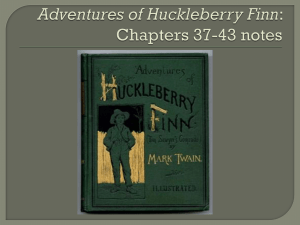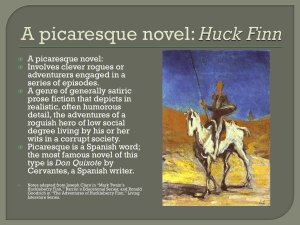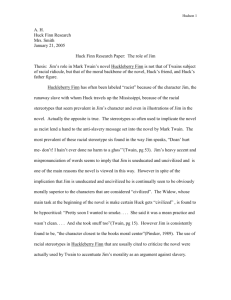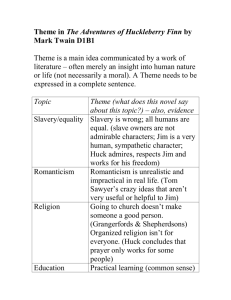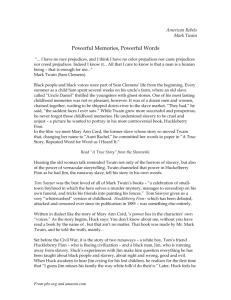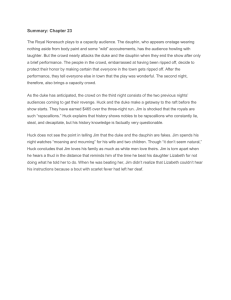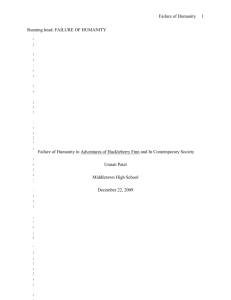People read novels to escape to another time and place. They wish
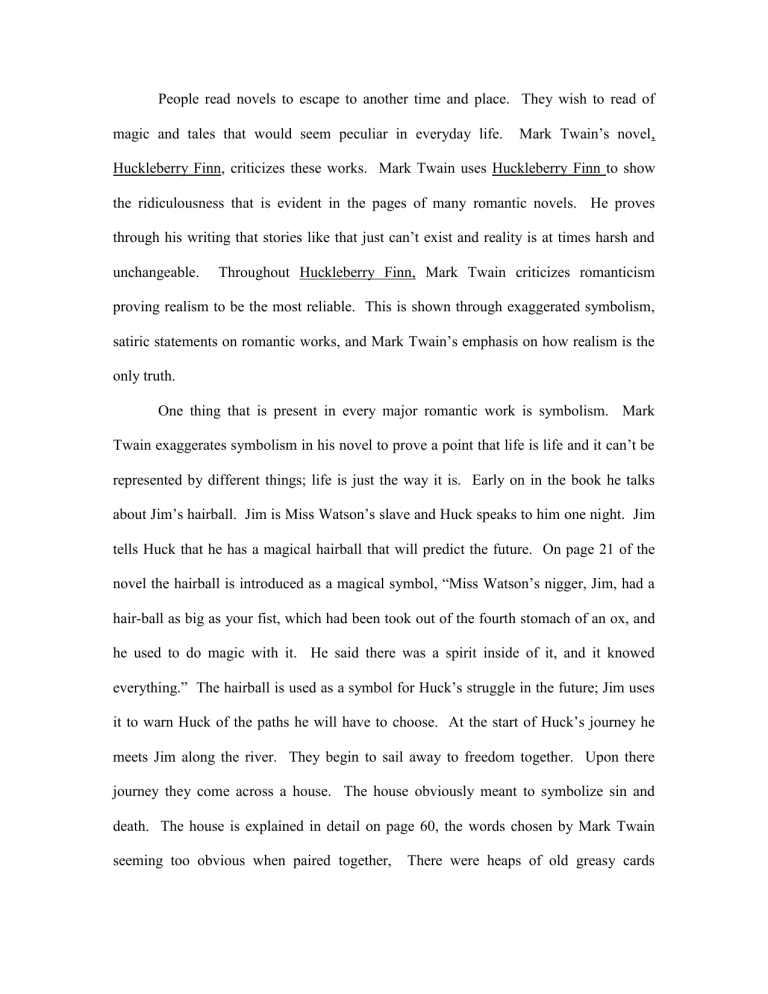
People read novels to escape to another time and place. They wish to read of magic and tales that would seem peculiar in everyday life. Mark Twain’s novel,
Huckleberry Finn, criticizes these works. Mark Twain uses Huckleberry Finn to show the ridiculousness that is evident in the pages of many romantic novels. He proves through his writing that stories like that just can’t exist and reality is at times harsh and unchangeable. Throughout Huckleberry Finn, Mark Twain criticizes romanticism proving realism to be the most reliable. This is shown through exaggerated symbolism, satiric statements on romantic works, and Mark Twain’s emphasis on how realism is the only truth.
One thing that is present in every major romantic work is symbolism. Mark
Twain exaggerates symbolism in his novel to prove a point that life is life and it can’t be represented by different things; life is just the way it is. Early on in the book he talks about Jim’s hairball. Jim is Miss Watson’s slave and Huck speaks to him one night. Jim tells Huck that he has a magical hairball that will predict the future. On page 21 of the novel the hairball is introduced as a magical symbol, “Miss Watson’s nigger, Jim, had a hair-ball as big as your fist, which had been took out of the fourth stomach of an ox, and he used to do magic with it. He said there was a spirit inside of it, and it knowed everything.” The hairball is used as a symbol for Huck’s struggle in the future; Jim uses it to warn Huck of the paths he will have to choose. At the start of Huck’s journey he meets Jim along the river. They begin to sail away to freedom together. Upon there journey they come across a house. The house obviously meant to symbolize sin and death. The house is explained in detail on page 60, the words chosen by Mark Twain seeming too obvious when paired together, There were heaps of old greasy cards
scattered around over the floor, and old whisky bottles, and a couple of masks made out of black cloth; and all over the walls was the ignorantest kind of words and pictures, made with charcoal. There was two old dirty pictures, made with charcoal...” Later on as the story proceeds Huck stays in a strange house owned by the Grangerford’s, an interesting family he meets upon his journey. Huck comes across a painting of suicide.
The painted was painted by Emaline, one of the daughters in the Grangerford’s household. The painting was meant to symbolize death and choices. On page 120 the poem is explained in detail, “It was a picture of a young woman in a long white gown, standing on the rail of a bridge all ready to jump off,...looking up at the moon, with tears running down her face, and she had two arms folded across her breast, and two arms stretched out in front, and two more reaching up towards the moon.” The painting was an obvious representation of death. Mark Twain added six arms to make it more ridiculous, and exaggerated.
Mark Twain pokes fun of romanticism through satire. He shows obvious over exaggerations of romantic stories in an attempt to show how truly ridiculous they are. He does this from the very beginning of the story, starting with Tom Sawyer. Tom sawyer is obsessed with novels. He becomes so consumed in them he uses it to run his whole life.
Tom Sawyer creates a gang, resembling something that would be seen in a novel. Tom
Sawyer introduces this idea of a gang on page 10 saying, “Now we’ll start this band of robbers and call it Tom Sawyer’s Gang. Everybody that wants to join has got to take an oath, and write his name in blood.” Mark Twain later pokes fun at poets such as Edgar
Allen Poe through Emalines dark poetry. On page 121, Huck finds all of Emalines dark
poetry, one of which is bizarre, clearly an attempt to mock poets obsessed with death.
“His soul did from the cold world fly, by falling down a well,” the poem read.
Not only does Twain stress the preposterousness of romanticism, but he stresses the truth in reality. He does this through Tom Sawyer. Tom Sawyer comes up with this brilliant plan to free Jim. He gathers all these ridiculous ideas from novels and convinces
Huck to go along with it. Tom Sawyer offers some of his crazy ideas on page 310 saying, “He slides out in her clothes. We’ll do that too.” In the end however his plan backfires and he ends up getting shot. He doesn’t end up saving Jim, because Jim was free to begin with. Miss Watson, Jim’s owner had died at the beginning of this book.
The fact that Jim was free this entire novel and Huck’s crazy adventures were all for nothing, further adds to the fact that reality is the only truth. No matter how many crazy adventures Huck went on, he couldn’t escape the truth. He didn’t magically save Jim, and he didn’t find a place where he fits in. He finds out what he should have already known. Huck discovers that he is too different from southern society and should travel out west. Huck says on page 338 that he doesn’t wish to be civilized he wishes to be his own person. “I got to light out for the territory ahead of the rest, because Aunt Sally she’s gonna adopt me and sivilize me,” he says. Jim was free the whole time; no romanticized plan would change that fact.
Mark Twain makes the point that realism is the only reliable source very clearly.
He does this by exaggerated symbolism. He uses ridiculous symbols like hair balls and pictures of death. Twain utilizes satire as well to show just how bizarre some stories are.
In the end Twain proves that realism is the only truth, by ending the story in a realistic
way. He doesn’t end it in tragedy or happy ever after, like most novels. He does however end it in a way that might essentially happen in the real world.

